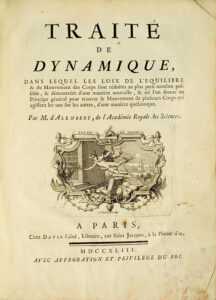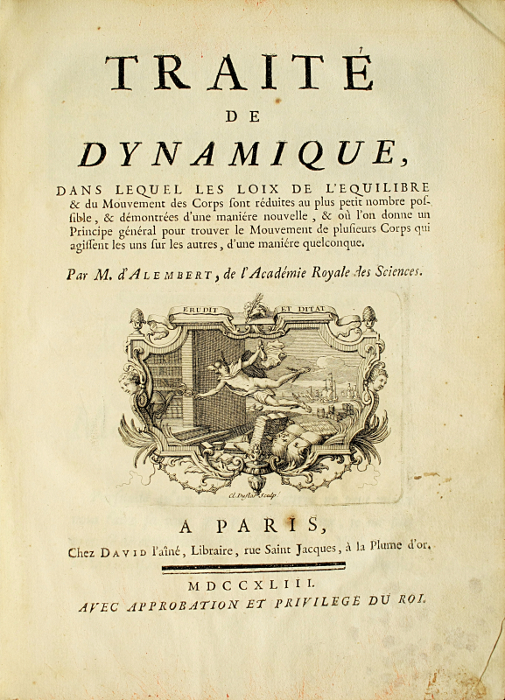Paris, David l’aîné, 1743.
4to of (2) ll., xxvi pp., (1) l. of table, 186 pp., 4 folding figures out of pagination, (1) l. of privilege. A few browned ll. without gravity on the back cover. Contemporary binding.
216 x 157 mm.
First edition of D’Alembert’s great mechanical treatise containing the principle under his name. P.M.M., 195; En Français dans le texte, n°147; Poggendorf I, 28; Wellcome II, p. 28; Norman 31
The “Treatise on Dynamics”, one of d’Alembert’s most famous scientific works, demonstrates d’Alembert clearly recognized that a scientific revolution had occurred and sets out to formalize the new science of mechanics – an accomplishment often misattributed to Newton. The first part of the treatise comprises d’Alembert’s own three laws of motion: inertia, the parallelogram of motion, and equilibrium. The second part contains the first statement of what has come to be known as “d’Alembert’s Principle” which states that the internal forces of inertia must be equal and opposite to the forces that produce the acceleration – a theory which is applied to many mechanical and technical problems, in particular to the theory of the motion of fluids.
“The ‘Treatise on Dynamics’ was d’Alembert’s first major book and it is a landmark in the history of mechanics. It reduces the laws of the motion of bodies to a law of equilibrium.” (P.M.M, 195).
“Published in 1743, the ‘Traité de dynamique’ offers a reduction and reunion of the mechanical problems of solid bodies. The first part is an analysis of the properties of the motions proper to these most fundamental laws, Newton’s three laws (inertia, composition of motions, equilibrium) followed by the wording of the demonstration of the general theorem of dynamic known since under the name of ‘D’Alembert’s principle’. The latter provides the general laws of any motion of systems of bodies, linked or not between them, free or forced by forces, by using the method of virtual placements. The second part applies D’Alembert’s principle to many classic problems of solid and fluid mechanics, of which solution was previously sought after as many special cases.” (En français dans le texte, n°147).
D’Alembert became famous for this publication.
Fine copy preserved in its elegant contemporary binding.



